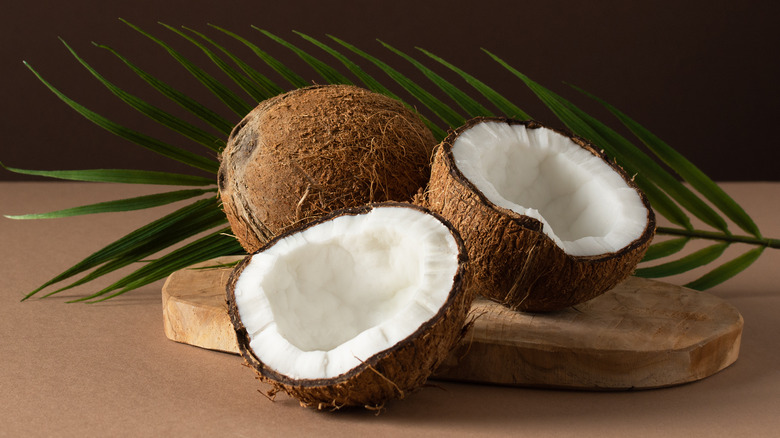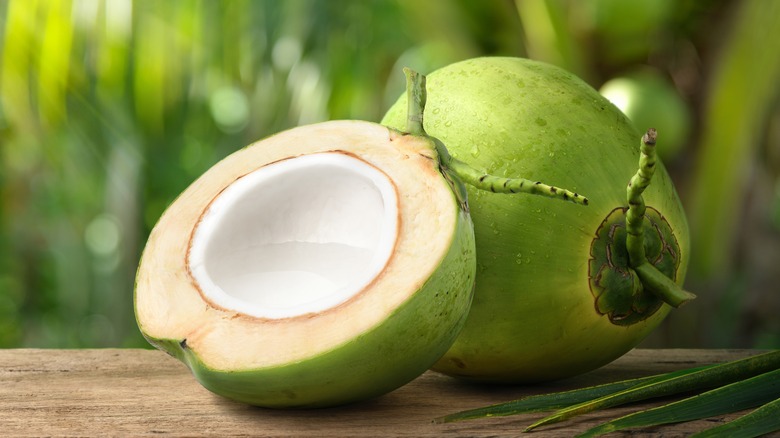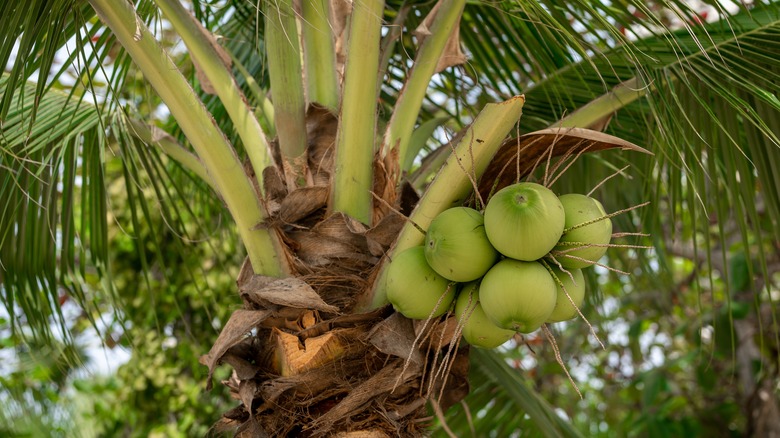Finally Find Out If Coconuts Are A Type Of Nut Or Not
When you visualize a grocery store, where do you think you can find coconuts? In the fresh food aisle next to mangos? Or in the packaged nuts section along with peanuts, almonds, cashews, and walnuts? For most of us it would be the former, even if the word "nut" is right there in coconut.
So why does the United States' Food and Drug Administration (FDA) classify coconut as a tree nut? And why does it matter to growers and food producers? To unpack this, we need to start with the definition of nuts.
Botanically speaking, a nut is a dry fruit with a hard shell covering a single seed. Chestnuts, hazelnuts, pecans, and walnuts are definitively nuts; peanuts and almonds are not nuts. Still, all these "nuts" are grouped together because that's how we've been trained as consumers. When it comes to coconuts, it gets a bit complex. Botanically, coconuts are drupes, not nuts. Drupes might be a relatively new term to some, and to be fair, it's not a word we often use.
Coconuts are drupes just like peaches and walnuts
A drupe's signature feature is its layers. There's the exocarp (outer layer or skin), the mesocarp (middle layer which can be fleshy or fibrous), and the endocarp (the pit which surrounds the seed). Nuts do not contain these protective layers. By this definition, coconuts, peaches, plums, walnuts, and almonds are also drupes, but we simply refer to them as either fruits or nuts. This simplified classification guides how we use them, botany be damned.
We also consume or value different parts of the drupes. When it comes to coconuts, we discard the exocarp and mesocarp and use the endocarp, which we typically refer to as the "coconut." With peaches, the bit we consume is the mesocarp since the endocarp is the inedible pit.
Coconuts might not qualify as nuts, but the term "nut" is often used colloquially to describe various edible seeds, regardless of their botanical classification. In a culinary sense, it does have nut-like characteristics. After all, coconut can be made into milk, oil, and flour.
A coalition wants to change FDA's classification of coconuts as tree nuts
It might be rather pedantic to debate the classification of coconut from a botany and culinary view, but it does matter. According to the FDA, tree nuts are among the top allergens in food, along with ingredients like milk and eggs, so these ingredients must be included or declared on food labels. Since this agency classifies coconut as a tree nut, any food that includes coconuts must be called out on the labels, which may deter people in the United States from consuming it. In comparison, countries like Australia classify coconuts as drupes, so the medical advice from The Royal Children's Hospital Melbourne, for example, is that coconuts are safe to eat for people with nut allergies.
There's an ongoing campaign by the Coconut Coalition of the Americas to remove coconuts from the list of "tree nuts" because it's neither a tree nut nor a major food allergen.
They do have a point on both counts. For one, coconuts don't even grow on trees, they grow on palms, specifically the coconut palm. This might seem like splitting hairs, but food classification really does come down to the minutiae. Additionally, fewer than 1% of the population is allergic to coconuts.
It will be interesting to see how this pans out.


